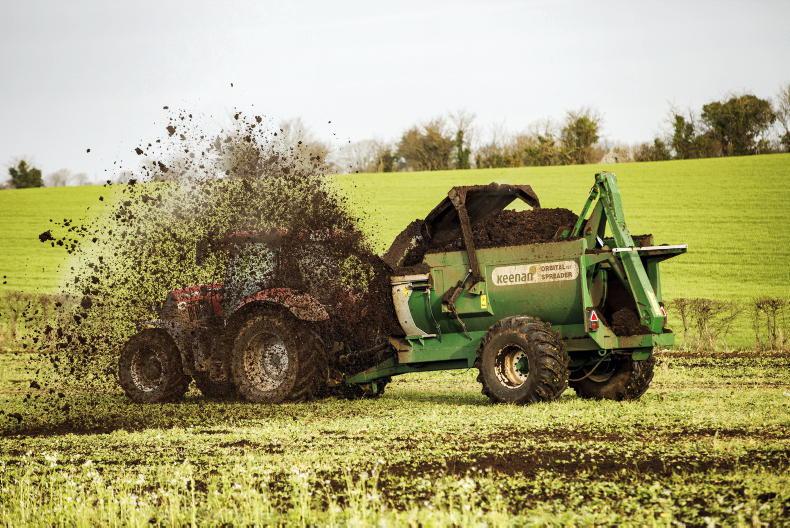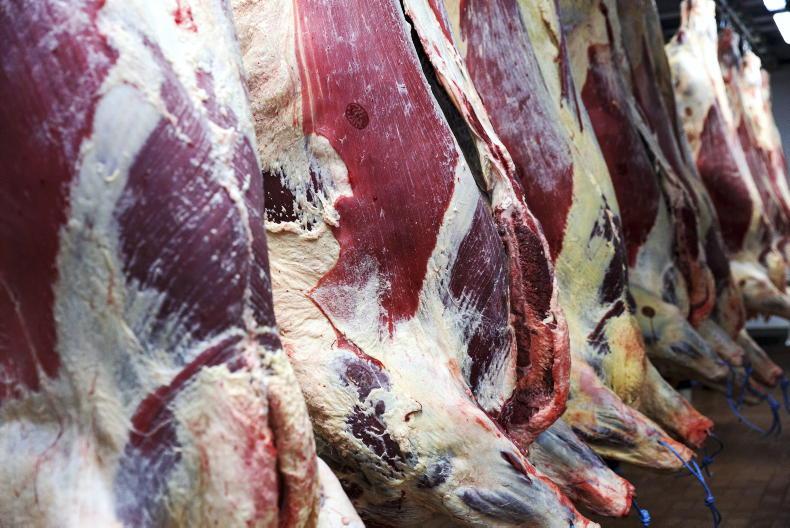Tillage is set to be hit hard if the current proposals for the Nitrates Action Programme go through.
As the country aims to cut fertiliser use by 20% the practicalities of achieving this target seem to be lost in the nitrates proposals.
In order to use less nitrogen, soil pH, phosphorus and potassium need to be at optimum levels and soil health and structure need to be improved. Applying organic manures can help with this.
A seven-day window to cultivate after a crop is difficult even in the driest of years
The proposed new rules do not seem to account for practicality or time constraints on farms.
A seven-day window to cultivate after a crop is difficult even in the driest of years, while a date of 15 September for closing the slurry spreading deadline is unworkable on some farms.
The nitrates proposal clearly states “these measures are intended to address the fact that there is a slurry storage deficit on approximately 40% of dairy farms”. However, other farmers are being hit with the consequences.
The slurry deadline
There is a lack of joined up thinking on how to achieve improvements in water and air quality, while reducing emissions.
Tillage land needs organic matter and nutrients, some farms have too much of these but there seems to be little in the way of harmony to join them together.
Indeed, the windows to get organic manures applied, especially for winter crops, is very tight and may even be tighter if the proposal to make 15 September the new cut-off date is implemented.
While it might seem strange to apply slurry to a tillage crop in the autumn, the fact remains that planting dates have moved earlier, enabling crops to achieve bigger volumes in the autumn and take up more nutrients from the soil or applied manure.
Yet there seems to be an attitude that winter crops take up little or no nutrients.
In some years some of the available nutrients will be left over from the previous crop
Many recent springs have seen vigorous debate about spring nitrogen management given the colour of crops and the amount of growth that took place over winter. Crop colour and bulk are proportional to nutrient uptake and this is very often quite high, especially with earlier planting.
In some years some of the available nutrients will be left over from the previous crop. It might also be applied as an organic fertiliser, either preceding that crop or in previous years. Either way, a winter cereal crop can very easily take up 50-80kg N/ha from early October planting, depending on the season, and nowadays many crops are sown even earlier.
Time lag on
pollution figures
Water quality is a serious issue and one which is extremely difficult to see results from in a short space of time. It may take six, 10 or even 20 years to see improvements as there is a time lag from when decisions are made to improve water quality to the time an actual improvement occurs.
In the Barrow and Slaney catchments, the EPA has attributed 27% of losses to arable land and the majority of losses across all catchments to grassland.
The area under low-nitrogen malting barley has increased
An 8,000t reduction in the nitrogen load was estimated to be needed from the Barrow catchment in 2018. In the past decade the area under tillage has declined by 15% (57,400ha). In that time the area planted to beans, which do not receive artificial N, has increased. The area under low-nitrogen malting barley has increased. The area under cover crops, catching nitrogen over winter, has increased.
Taking beans as an example, the planting of approximately 10,000ha of the crop takes around 6,600t of straight nitrogen out of use.
Mandatory cultivation seven days post-harvest
Another proposal in the nitrates review which is directly applicable to tillage farmers is the regulation around green cover.
Under current requirements, green cover must be naturally regenerated within six weeks from harvest in order to reduce any potential losses of nutrients.
However, it is now proposed that shallow cultivation of stubble must be undertaken within seven days post-harvest. The measure aims to germinate volunteers and weeds as early as possible to allow them to soak up residual nitrogen and other nutrients.
If establishing cover crops was made mandatory under nitrate regulations, it wouldn’t be eligible to be included as a grant-aided measure
All growing vegetation has the potential to take up nutrients. The earlier the vegetation establishes, the more nutrients it can take up.
Arguably this measure is much more favourable than that of, say, mandatory cover crops.
If establishing cover crops was made mandatory under nitrate regulations, it wouldn’t be eligible to be included as a grant-aided measure under future environmental schemes and would add expense to farms.
Furthermore, Teagasc research has shown similar nitrogen uptake levels from natural regeneration as from cover crops.
Tight window
However, a seven-day window from harvest to cultivation is extremely tight. For a season like 2021, where the weather allowed for a smooth harvest with low grain moistures and a speedy removal of straw, this time frame may be workable.
But during a broken harvest, where straw is lying and a grower’s main priority is to get grain harvested and dried, this time frame won’t be workable.
Therefore, there needs to be a degree of leniency from the Department if enforcing the measure.
Late harvested and root crops
The proposals also mention that additional requirements are needed for late-harvested crops such as potatoes, maize and late harvested spring cereal crops, especially those in critical source areas.
While few details have been given, these measures could include putting in place appropriate buffers between the crops and identified critical source areas to protect water bodies.
Tillage is extremely
nitrogen efficient
The reality is that as tillage area has decreased in this country, water quality issues have increased. Nitrogen use efficiency in tillage is 65-70%, compared with 25% on dairy farms.
If we are to improve water quality in this country and reduce dependence on artificial fertilisers we need more sustainable and integrated systems.
If tillage farmers can no longer apply slurry after 15 September not only do they need to find a home for the slurry from their livestock enterprises, but many livestock farmers exporting slurry will need to find a home for their slurry.
The new proposals are causing undue pressure on a sector which has seen a steady decline in area, despite its low carbon footprint.

Tillage is set to be hit hard if the current proposals for the Nitrates Action Programme go through.
As the country aims to cut fertiliser use by 20% the practicalities of achieving this target seem to be lost in the nitrates proposals.
In order to use less nitrogen, soil pH, phosphorus and potassium need to be at optimum levels and soil health and structure need to be improved. Applying organic manures can help with this.
A seven-day window to cultivate after a crop is difficult even in the driest of years
The proposed new rules do not seem to account for practicality or time constraints on farms.
A seven-day window to cultivate after a crop is difficult even in the driest of years, while a date of 15 September for closing the slurry spreading deadline is unworkable on some farms.
The nitrates proposal clearly states “these measures are intended to address the fact that there is a slurry storage deficit on approximately 40% of dairy farms”. However, other farmers are being hit with the consequences.
The slurry deadline
There is a lack of joined up thinking on how to achieve improvements in water and air quality, while reducing emissions.
Tillage land needs organic matter and nutrients, some farms have too much of these but there seems to be little in the way of harmony to join them together.
Indeed, the windows to get organic manures applied, especially for winter crops, is very tight and may even be tighter if the proposal to make 15 September the new cut-off date is implemented.
While it might seem strange to apply slurry to a tillage crop in the autumn, the fact remains that planting dates have moved earlier, enabling crops to achieve bigger volumes in the autumn and take up more nutrients from the soil or applied manure.
Yet there seems to be an attitude that winter crops take up little or no nutrients.
In some years some of the available nutrients will be left over from the previous crop
Many recent springs have seen vigorous debate about spring nitrogen management given the colour of crops and the amount of growth that took place over winter. Crop colour and bulk are proportional to nutrient uptake and this is very often quite high, especially with earlier planting.
In some years some of the available nutrients will be left over from the previous crop. It might also be applied as an organic fertiliser, either preceding that crop or in previous years. Either way, a winter cereal crop can very easily take up 50-80kg N/ha from early October planting, depending on the season, and nowadays many crops are sown even earlier.
Time lag on
pollution figures
Water quality is a serious issue and one which is extremely difficult to see results from in a short space of time. It may take six, 10 or even 20 years to see improvements as there is a time lag from when decisions are made to improve water quality to the time an actual improvement occurs.
In the Barrow and Slaney catchments, the EPA has attributed 27% of losses to arable land and the majority of losses across all catchments to grassland.
The area under low-nitrogen malting barley has increased
An 8,000t reduction in the nitrogen load was estimated to be needed from the Barrow catchment in 2018. In the past decade the area under tillage has declined by 15% (57,400ha). In that time the area planted to beans, which do not receive artificial N, has increased. The area under low-nitrogen malting barley has increased. The area under cover crops, catching nitrogen over winter, has increased.
Taking beans as an example, the planting of approximately 10,000ha of the crop takes around 6,600t of straight nitrogen out of use.
Mandatory cultivation seven days post-harvest
Another proposal in the nitrates review which is directly applicable to tillage farmers is the regulation around green cover.
Under current requirements, green cover must be naturally regenerated within six weeks from harvest in order to reduce any potential losses of nutrients.
However, it is now proposed that shallow cultivation of stubble must be undertaken within seven days post-harvest. The measure aims to germinate volunteers and weeds as early as possible to allow them to soak up residual nitrogen and other nutrients.
If establishing cover crops was made mandatory under nitrate regulations, it wouldn’t be eligible to be included as a grant-aided measure
All growing vegetation has the potential to take up nutrients. The earlier the vegetation establishes, the more nutrients it can take up.
Arguably this measure is much more favourable than that of, say, mandatory cover crops.
If establishing cover crops was made mandatory under nitrate regulations, it wouldn’t be eligible to be included as a grant-aided measure under future environmental schemes and would add expense to farms.
Furthermore, Teagasc research has shown similar nitrogen uptake levels from natural regeneration as from cover crops.
Tight window
However, a seven-day window from harvest to cultivation is extremely tight. For a season like 2021, where the weather allowed for a smooth harvest with low grain moistures and a speedy removal of straw, this time frame may be workable.
But during a broken harvest, where straw is lying and a grower’s main priority is to get grain harvested and dried, this time frame won’t be workable.
Therefore, there needs to be a degree of leniency from the Department if enforcing the measure.
Late harvested and root crops
The proposals also mention that additional requirements are needed for late-harvested crops such as potatoes, maize and late harvested spring cereal crops, especially those in critical source areas.
While few details have been given, these measures could include putting in place appropriate buffers between the crops and identified critical source areas to protect water bodies.
Tillage is extremely
nitrogen efficient
The reality is that as tillage area has decreased in this country, water quality issues have increased. Nitrogen use efficiency in tillage is 65-70%, compared with 25% on dairy farms.
If we are to improve water quality in this country and reduce dependence on artificial fertilisers we need more sustainable and integrated systems.
If tillage farmers can no longer apply slurry after 15 September not only do they need to find a home for the slurry from their livestock enterprises, but many livestock farmers exporting slurry will need to find a home for their slurry.
The new proposals are causing undue pressure on a sector which has seen a steady decline in area, despite its low carbon footprint.











SHARING OPTIONS